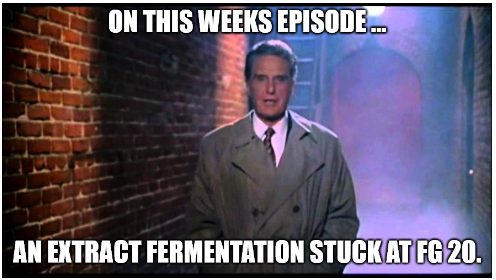Hi all,
I'm a brand new home brewer and working on my 2nd batch. My first was a extract kit that I purchased from MoreBeer! and was an American Red Ale. It was so much better than I was expecting for my first beer! I'm totally hooked.
I came across a clone recipe for St. Stan's Red Sky Ale and being from Modesto ( where St. Stan's was founded) and as a lover of Red Ales, I had to try it. I purchased this extract kit from Austin Home Brew (AHB). I performed a full boil using six (s) gallons of water and the brew day seemed to go well. AHB recommended SafeAle S-33 yeast for this recipe, which I used. The yeast kicked in about eight (8) hours later and was creating lots of bubbles in the airlock for about two (2) days. I slowed down significantly after that. At least based on airlock bubbles.
My fermzilla carboy is somewhat temperature controlled in basically a big insulated keg jacket/enclosure. I keep the temps moderated with frozen gallon and half gallon water containers. I've been able to keep the temps between 64 and 68 degrees F. I've let the temp move upwards more towards 68 degrees F the last two days.
The recipe indicated that OG would be 1.057, but my reading was 1.051 before pitching the yeast. I took my next specific gravity reading eight days after brew day and it read 1.020. Four (4) days later I took another reading and it was still at 1.020. I was hoping to bottle my batch this weekend, assuming the specific gravity was stable, but the current reading is significantly higher than the predicted FG of 1.013.
I'm concerned that my OG and current and potential FG are off a fair amount from the predicted recipe numbers. Of course I'll take another specific gravity this weekend, but I'm concerned it will still be 1.020.
Would this be considered a stalled fermentation and if so, is there anything I can do?
I've read about stirring the batch or agitating it, but then I've read that's not good to do as it will introduce oxygen into the beer. I read you could add more yeast and a few other things, but I don't know if any of these ideas are appropriate and if, indeed, do I have a case of stalled fermentation.
Any suggestions would really be appreciated!
I'm a brand new home brewer and working on my 2nd batch. My first was a extract kit that I purchased from MoreBeer! and was an American Red Ale. It was so much better than I was expecting for my first beer! I'm totally hooked.
I came across a clone recipe for St. Stan's Red Sky Ale and being from Modesto ( where St. Stan's was founded) and as a lover of Red Ales, I had to try it. I purchased this extract kit from Austin Home Brew (AHB). I performed a full boil using six (s) gallons of water and the brew day seemed to go well. AHB recommended SafeAle S-33 yeast for this recipe, which I used. The yeast kicked in about eight (8) hours later and was creating lots of bubbles in the airlock for about two (2) days. I slowed down significantly after that. At least based on airlock bubbles.
My fermzilla carboy is somewhat temperature controlled in basically a big insulated keg jacket/enclosure. I keep the temps moderated with frozen gallon and half gallon water containers. I've been able to keep the temps between 64 and 68 degrees F. I've let the temp move upwards more towards 68 degrees F the last two days.
The recipe indicated that OG would be 1.057, but my reading was 1.051 before pitching the yeast. I took my next specific gravity reading eight days after brew day and it read 1.020. Four (4) days later I took another reading and it was still at 1.020. I was hoping to bottle my batch this weekend, assuming the specific gravity was stable, but the current reading is significantly higher than the predicted FG of 1.013.
I'm concerned that my OG and current and potential FG are off a fair amount from the predicted recipe numbers. Of course I'll take another specific gravity this weekend, but I'm concerned it will still be 1.020.
Would this be considered a stalled fermentation and if so, is there anything I can do?
I've read about stirring the batch or agitating it, but then I've read that's not good to do as it will introduce oxygen into the beer. I read you could add more yeast and a few other things, but I don't know if any of these ideas are appropriate and if, indeed, do I have a case of stalled fermentation.
Any suggestions would really be appreciated!
Last edited:



















































![Craft A Brew - Safale S-04 Dry Yeast - Fermentis - English Ale Dry Yeast - For English and American Ales and Hard Apple Ciders - Ingredients for Home Brewing - Beer Making Supplies - [1 Pack]](https://m.media-amazon.com/images/I/41fVGNh6JfL._SL500_.jpg)







